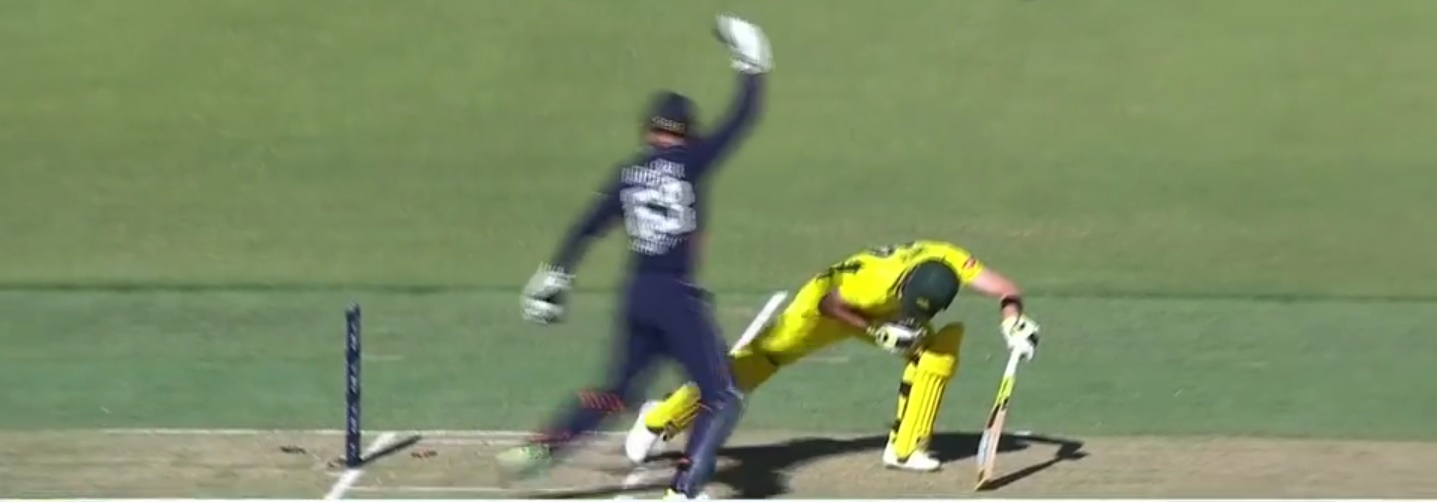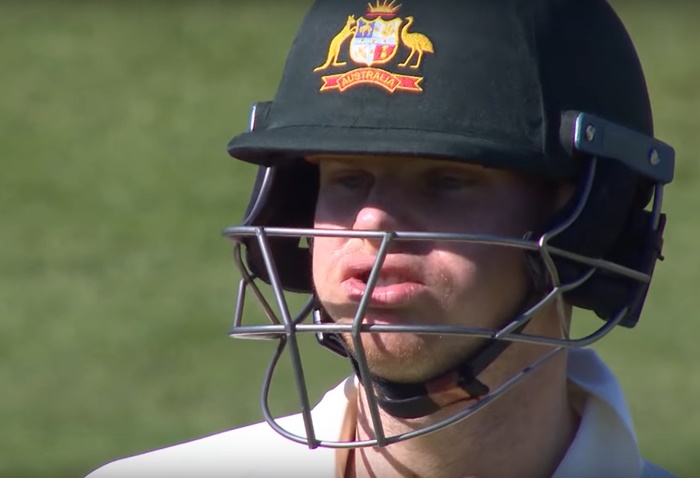
Remember averages and strike-rates?
We do.
Let’s take a look at some of the meat and potatoes stats for England’s 4-1 one-day series win over Australia.
Steve Smith ate balls
The Australian captain ate up 148 deliveries over the course of the series and yet paid his team back with just 102 runs.
Steve Smith is a greedy ball-eater and not at all generous to his team-mates in his approach to run-scoring.
This is the danger when a one-day batsman’s defence is too reliable – he can actually fall back on it.
Australia took wickets
England had just three bowlers who averaged less than Chris Woakes’ 39. Adil Rashid averaged 29.90, Liam Plunkett averaged 30.00 and Tom Curran averaged 7.50.
In contrast, six Aussies averaged less than Woakes, and of those, five averaged less than 30.
Moral of the story: up until the tenth and final one, wickets have little intrinsic value in one-day cricket.
Plenty of batting to come
Steve Smith says that England’s habit of absolutely caning it until they run out of batsmen is risky – but it’s less risky than for most teams because of how they pick their side.
England’s batsmen are more disposable and each of their wickets is therefore less valuable to the opposition. With big biffer Liam Plunkett – a man with three first-class hundreds to his name – at number 10, the top order can afford to chance their arm that bit more.
The benefit of the approach (quicker run-scoring throughout the innings) is generally greater than the cost (greater likelihood of losing wickets) in large part because of the point made in the previous section.
Chris Woakes averaged 170
And scored 117 runs per 100 balls.
Chris Woakes bats at eight.
England won the run-outs 4-1
The same as the series score. Coincidence?
(It’s quite possible we just added this up wrong, because life’s too short for double-checking.)
Moeen Ali was economical, Adil Rashid was expensive (but took 10 wickets)
Different bowlers who go about things in different ways. It’s good for a captain to be able to call on both.



Must admit I was surprised at how bad the England bowling averages were, but that is countered by the economy rates. Mo and Rashid tend to look after themselves as you say, but of the seamers only Plunkett went for more than 6 an over.
Woakes and Wood (who tend to top and tail the innings) both went for less then 5.5, which is a pretty awful effort from Australia when you consider that they were only bowled out in the game those two didn’t play. In that game, Willey and Curran went for even less.
On the batting side, Smith has taken some heat but all the strike rates of the middle are pretty dreadful too – March (85), Head (80), White (66) and Paine (82).
It’s almost like this is silly joke, and the teams have been wearing the wrong kits.
Smith’s strike-rate (68.91) compares unfavourably with those. White only faced 50 balls, so can’t really blame him for wasting too many overs.
England’s batting style is risky. Based on recent evidence it can lose you 1 game in five.
Batting more slowly is also risky. One risks not getting enough runs. recent evidence is this happens about four times more often. Since the “risk” in limited overs cricket is the risk of losing the match, it could be arguable that batting too slowly is far riskier that going hard.
So, let’s break this down a little.
In what I’ll call (for want of a better descriptor) the “Jason Roy First Ball Duck Epoch” or JRFBDE for short, England have played 57 matches and of which Jason Roy has played 52 (he also played in Malahide, but didn’t bat due to it being, you know, Malahide).
In the JRFBDE, England have won 38 matches, lost 16, tied 1 and been denied a result in 1. Essentially, they have lost around 1 match in 4.
Their record since the start of 2017 (The Era of the Jason Roy Hokey-Cokey- i.e. In, Out, In, Out, Shake It All About, EJRHC) has been played 25, and lost 5 (including a crucial semi-final defeat to Pakistan). The EJHRC has been when they’ve picked up their win rate, but that has seen substantial thrashings of the weaker sides: West Indies, Ireland and Australia (played 6, won 5 in the case of the last of those).
Against India and South Africa, their record is Played 6, Won 3, Lost 3; and their match against Pakistan was an 8 wicket thrashing. In other words, it’s impossible to say whether or not England lack a “big match temperament” right now, as 1 match does not yet give enough data.
We can however, definitively state that Australia’s approach is shite. Play like it’s the mid 2000s and hope nobody notices Ricky Ponting and Adam Gilchrist are in the commentary box will lead you to win a grand total of 0 matches in ICC tournaments on English soil.
In other news.
If anyone wants a giggle, since their triumph in the 1999 Men’s World cup there have been 4 ICC sanctioned limited overs tournaments- 1 World T20 and 3 Champions Trophies.
How many matches in that time do you expect Australia to have won.
I’ll give you a clue, it’s a smaller number than you think.
It was 2, both in the group round of the 2004 Champion’s Trophy (after which they were defeated by England in the semi finals).
http://www.espncricinfo.com/series/18527/scorecard/1130744/bangladesh-vs-sri-lanka-1st-test-sri-lanka-tour-of-bangladesh-2018
Tremendis
At least it isn’t one of those double-century wickets.
Don’t we all hate those?
We like our high-scoring bore draw wickets to make it very tricky for the individual batsman when he gets to that 175-200 run zone, don’t we?
In other news, found this and thought it might meet with approval
https://www.sporcle.com/games/chaosBEE/cricket-venn-diagram
Lovely stuff.
That is so cool.
It is ludicrous in a way that such a thing makes me happy, but it does.
My life is complete
I managed 75%. Even when playing it a second time. Not as easy as it looks because the questions and the answers don’t change.
Can’t top the Venn diagram quiz, but here is a connections puzzle from yesterday.
Which 20th century cricketer is the strange coincidental connection between three of my current preoccupations; Brexit, Middlesex Cricket and real tennis?
In truth, the only way you’ll find out is by clicking the link below:
http://ianlouisharris.com/2018/02/01/the-lords-then-lords-plus-a-coincidental-segue-between-the-two-1-february-2018/
Small clue – KC – do you have any interest in a “cricketer’s grandson spotted” for Cricket Badger? i know your pipeline’s a bit thin.
We’ve a few in the queue but we’d probably say yes to that even if we didn’t anticipate future dry spells. Send it over.
Is it a cowdrey?
No, but nice try. There really is only one way to find out, Bradders.
All this talk of England having cracked the ODI code. Will the code still remain the same when the World Cup is played in England in 2019?
(Nothing against England winning ODI games, just that in conditions that favour bowlers more, the ‘select 10 batsmen and score 300+’ formula might not work like it does on flat pitches.)
No, it doesn’t. How good they are as a side greatly depends on learning to pace innings within their own “wickets are cheap and disposable” framework.
I think all anyone in England thinks is that at least this time they shouldn’t embarrass themselves. There is at least *some* sort of plan.
In 2019, I would expect to see all venues trying to produce belters for the England ODI matches.
Not sure that they can regulate the English weather, though.
I agree with KC, the team batting first still has to assess what a good score is, given the prevailing conditions. But the decisions on what to do about it in play are slightly different if/when you know there is plenty of batting to come.
The bowler’s Lyon, the batsman’s Willey. Or something.
It rather answer the question why Lyon doesn’t turn out for Australia in pajama cricket more often
Willey wangs Lyon’s balls
http://www.espncricinfo.com/series/8368/report/1116941/
Manjotory U19 finals link, kalramitous for the Aussies.